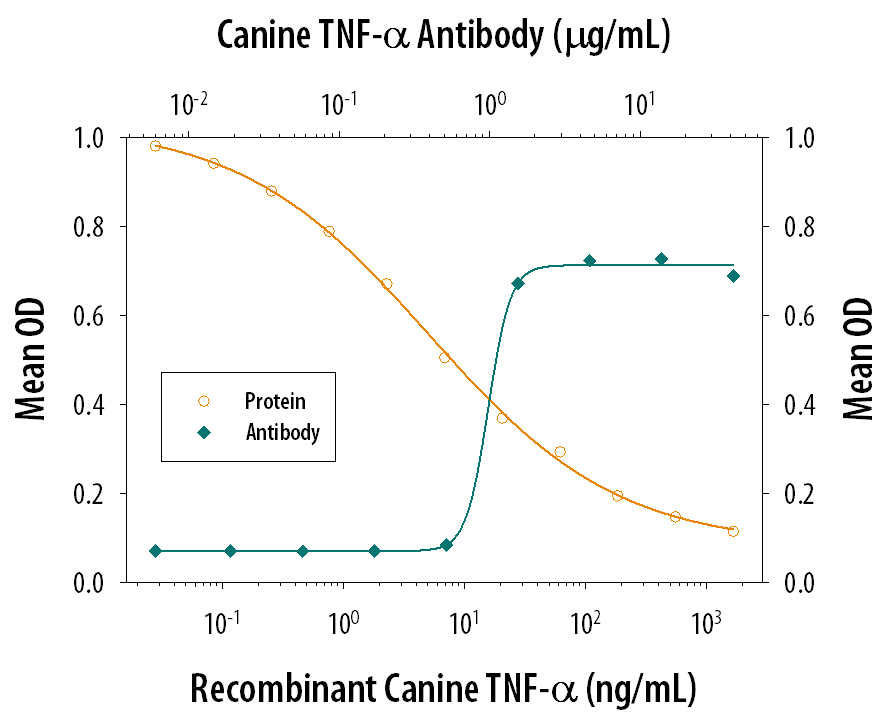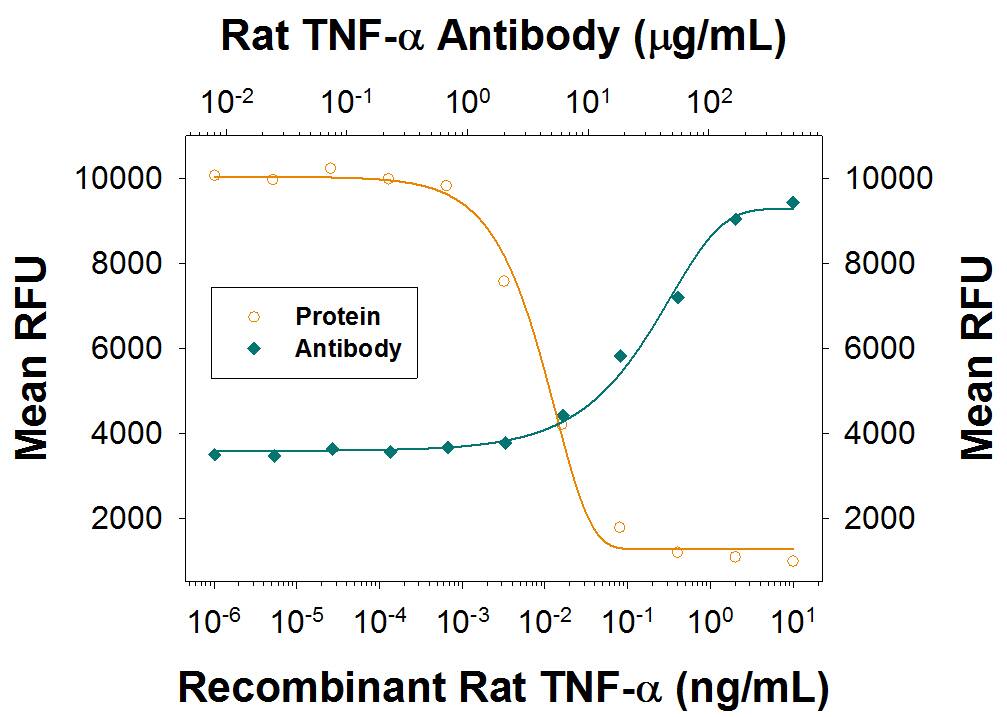TNF-alpha Products
TNF-alpha (Tumor necrosis factor alpha) plays a central role in inflammation, immune system development, apoptosis, and lipid metabolism. TNF-alpha was first identified as a cytotoxic factor produced by macrophages capable of killing mouse tumor cells. It is the prototypic ligand and along with Lymphotoxin-alpha, were identified as the first members of the TNF superfamily. Active TNF-alpha and other members of the TNF superfamily exist as a homotrimer with high structural homology. Receptor binding occurs at the interface of two TNF-alpha monomers. And receptor activation occurs when all three monomer interfaces are engaged with a receptor. For TNF-alpha, receptor binding and activation occurs through TNF R1 or TNF RII, and subsequently leads to activation of NF-kB or MAPK signaling pathways. Another pathway that TNF-alpha can activate utilizes the death domain of TNF RI to induce apoptosis. TNF-alpha promotes the inflammatory response largely through NF-kB signaling, and inhibition of TNF-alpha has proven successful in treating many autoimmune disorders. TNF-alpha is also present on the cell surface as membrane-bound TNF-alpha can induce the lysis of neighboring tumor cells and virus infected cells. TNF-alpha protein is translated as a type II transmembrane protein containing an N-terminal transmembrane domain. The soluble cytokine is released from its cell-anchoring TM domain by proteolytic processing by metalloproteases.
37 results for "TNF-alpha" in Products
37 results for "TNF-alpha" in Products
TNF-alpha Products
TNF-alpha (Tumor necrosis factor alpha) plays a central role in inflammation, immune system development, apoptosis, and lipid metabolism. TNF-alpha was first identified as a cytotoxic factor produced by macrophages capable of killing mouse tumor cells. It is the prototypic ligand and along with Lymphotoxin-alpha, were identified as the first members of the TNF superfamily. Active TNF-alpha and other members of the TNF superfamily exist as a homotrimer with high structural homology. Receptor binding occurs at the interface of two TNF-alpha monomers. And receptor activation occurs when all three monomer interfaces are engaged with a receptor. For TNF-alpha, receptor binding and activation occurs through TNF R1 or TNF RII, and subsequently leads to activation of NF-kB or MAPK signaling pathways. Another pathway that TNF-alpha can activate utilizes the death domain of TNF RI to induce apoptosis. TNF-alpha promotes the inflammatory response largely through NF-kB signaling, and inhibition of TNF-alpha has proven successful in treating many autoimmune disorders. TNF-alpha is also present on the cell surface as membrane-bound TNF-alpha can induce the lysis of neighboring tumor cells and virus infected cells. TNF-alpha protein is translated as a type II transmembrane protein containing an N-terminal transmembrane domain. The soluble cytokine is released from its cell-anchoring TM domain by proteolytic processing by metalloproteases.
Analyzed by SEC-MALS
| Source: | E. coli |
| Accession #: | P06804 |
| Applications: | BA |
| Reactivity: | Human, Mouse |
| Details: | Goat IgG Polyclonal |
| Applications: | WB, IHC, CyTOF-ready, ICC, ICFlow, +1 More |
| Source: | E. coli |
| Accession #: | P16599 |
| Applications: | BA |
Animal-Free.
| Source: | E. coli |
| Accession #: | P01375.1 |
| Applications: | BA |
| Reactivity: | Human |
| Details: | Goat IgG Polyclonal |
| Applications: | WB, ICC, Neut |
| Reactivity: | Rat |
| Details: | Goat IgG Polyclonal |
| Applications: | WB, ICC, Neut |
| Reactivity: | Mouse |
| Details: | Rat IgG1 Monoclonal Clone #MP6-XT22 |
| Applications: | ICFlow, Neut |
| Reactivity: | Human |
| Details: | Mouse IgG1 Monoclonal Clone #1825 |
| Applications: | Neut |
| Reactivity: | Rat |
| Details: | Mouse IgG1 Monoclonal Clone #45418 |
| Applications: | WB, Neut |
| Source: | E. coli |
| Accession #: | P01375 |
| Applications: | BA |
| Reactivity: | Mouse |
| Details: | Goat IgG Polyclonal |
| Applications: | WB, Neut |
| Source: | E. coli |
| Accession #: | P06804 |
| Applications: | BA |
| Reactivity: | Human |
| Details: | Mouse IgG1 Monoclonal Clone #6401 |
| Applications: | Flow, CyTOF-ready, Neut |
| Source: | E. coli |
| Accession #: | P23563 |
| Applications: | BA |
| Source: | E. coli |
| Accession #: | Q06599 |
| Applications: | BA |
| Reactivity: | Human |
| Details: | Goat IgG Polyclonal |
| Applications: | WB, Neut |
| Reactivity: | Porcine |
| Details: | Mouse IgG1 Monoclonal Clone #103302 |
| Applications: | WB, ICC, Neut |
| Reactivity: | Porcine |
| Details: | Goat IgG Polyclonal |
| Applications: | WB, ICC, Neut |
Intended for preclinical researchers who may transition to GMP TNF-alpha for their clinical work
| Source: | E. coli |
| Accession #: | P01375.1 |
| Applications: | BA |
| Source: | E. coli |
| Accession #: | CAA64403 |
| Applications: | BA |
| Reactivity: | Canine |
| Details: | Goat IgG Polyclonal |
| Applications: | WB, ICC, Neut |
| Source: | E. coli |
| Accession #: | NP_001075288 |
| Applications: | BA |
Mutant form with approximately 5-fold greater activity
| Source: | E. coli |
| Accession #: | P01375 |
| Applications: | BA |
| Reactivity: | Canine |
| Details: | Mouse IgG1 Monoclonal Clone #236812 |
| Applications: | ICC, Neut |
Recombinant Monoclonal Antibody.
| Reactivity: | Rat |
| Details: | Mouse IgG1 Monoclonal Clone #45418R |
| Applications: | Neut |




















